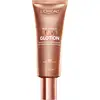What's inside
What's inside
 Key Ingredients
Key Ingredients

 Benefits
Benefits

 Concerns
Concerns

 Ingredients Side-by-side
Ingredients Side-by-side

Water
Skin ConditioningDimethicone
EmollientIsohexadecane
EmollientC13-15 Alkane
SolventSynthetic Fluorphlogopite
Glycerin
HumectantEthylhexyl Palmitate
EmollientCetyl PEG/PPG-10/1 Dimethicone
EmulsifyingSilica
AbrasiveMica
Cosmetic ColorantQuaternium-90 Bentonite
Glyceryl Tribehenate/Isostearate/Eicosandioate
EmollientSodium Chloride
MaskingPhenoxyethanol
PreservativeHydrogenated Castor Oil
EmollientPolyhydroxystearic Acid
EmulsifyingLecithin
EmollientTriethyl Citrate
MaskingIsopropyl Myristate
EmollientIsostearic Acid
CleansingPolyglyceryl-3 Polyricinoleate
EmulsifyingTocopheryl Acetate
AntioxidantEthylhexylglycerin
Skin ConditioningPentaerythrityl Tetra-Di-T-Butyl Hydroxyhydrocinnamate
AntioxidantRosa Rubiginosa Seed Oil
EmollientPunica Granatum Seed Oil
EmollientCarthamus Tinctorius Seed Oil
MaskingCitrullus Lanatus Fruit Extract
Skin ConditioningTocopherol
AntioxidantAluminum Hydroxide
EmollientTin Oxide
AbrasiveCI 77891
Cosmetic ColorantIron Oxides
CI 15850
Cosmetic ColorantWater, Dimethicone, Isohexadecane, C13-15 Alkane, Synthetic Fluorphlogopite, Glycerin, Ethylhexyl Palmitate, Cetyl PEG/PPG-10/1 Dimethicone, Silica, Mica, Quaternium-90 Bentonite, Glyceryl Tribehenate/Isostearate/Eicosandioate, Sodium Chloride, Phenoxyethanol, Hydrogenated Castor Oil, Polyhydroxystearic Acid, Lecithin, Triethyl Citrate, Isopropyl Myristate, Isostearic Acid, Polyglyceryl-3 Polyricinoleate, Tocopheryl Acetate, Ethylhexylglycerin, Pentaerythrityl Tetra-Di-T-Butyl Hydroxyhydrocinnamate, Rosa Rubiginosa Seed Oil, Punica Granatum Seed Oil, Carthamus Tinctorius Seed Oil, Citrullus Lanatus Fruit Extract, Tocopherol, Aluminum Hydroxide, Tin Oxide, CI 77891, Iron Oxides, CI 15850
Water
Skin ConditioningGlycerin
HumectantCyclohexasiloxane
EmollientAlcohol Denat.
AntimicrobialSynthetic Fluorphlogopite
Butyrospermum Parkii Butter
Skin ConditioningDimethicone
EmollientAmmonium Polyacryloyldimethyl Taurate
Emulsion StabilisingPolyglyceryl-6 Distearate
EmulsifyingMica
Cosmetic ColorantCI 77891
Cosmetic ColorantPolysilicone-11
Phenoxyethanol
PreservativePentaerythrityl Tetraethylhexanoate
EmollientCI 77491
Cosmetic ColorantJojoba Esters
EmollientCapryloyl Salicylic Acid
ExfoliatingCaprylyl Glycol
EmollientPolyacrylamide
Boron Nitride
AbsorbentPolyglyceryl-3 Beeswax
EmulsifyingCetyl Alcohol
EmollientC13-14 Isoparaffin
EmollientAdenosine
Skin ConditioningDisodium EDTA
Laureth-7
EmulsifyingSodium Hydroxide
BufferingTin Oxide
AbrasiveCitric Acid
BufferingCeramide AP
Skin ConditioningWater, Glycerin, Cyclohexasiloxane, Alcohol Denat., Synthetic Fluorphlogopite, Butyrospermum Parkii Butter, Dimethicone, Ammonium Polyacryloyldimethyl Taurate, Polyglyceryl-6 Distearate, Mica, CI 77891, Polysilicone-11, Phenoxyethanol, Pentaerythrityl Tetraethylhexanoate, CI 77491, Jojoba Esters, Capryloyl Salicylic Acid, Caprylyl Glycol, Polyacrylamide, Boron Nitride, Polyglyceryl-3 Beeswax, Cetyl Alcohol, C13-14 Isoparaffin, Adenosine, Disodium EDTA, Laureth-7, Sodium Hydroxide, Tin Oxide, Citric Acid, Ceramide AP
 Reviews
Reviews

Ingredients Explained
These ingredients are found in both products.
Ingredients higher up in an ingredient list are typically present in a larger amount.
Ci 77891 is a white pigment from Titanium dioxide. It is naturally found in minerals such as rutile and ilmenite.
It's main function is to add a white color to cosmetics. It can also be mixed with other colors to create different shades.
Ci 77891 is commonly found in sunscreens due to its ability to block UV rays.
Learn more about CI 77891Dimethicone is a type of synthetic silicone created from natural materials such as quartz.
What it does:
Dimethicone comes in different viscosities:
Depending on the viscosity, dimethicone has different properties.
Ingredients lists don't always show which type is used, so we recommend reaching out to the brand if you have questions about the viscosity.
This ingredient is unlikely to cause irritation because it does not get absorbed into skin. However, people with silicone allergies should be careful about using this ingredient.
Note: Dimethicone may contribute to pilling. This is because it is not oil or water soluble, so pilling may occur when layered with products. When mixed with heavy oils in a formula, the outcome is also quite greasy.
Learn more about DimethiconeGlycerin is already naturally found in your skin. It helps moisturize and protect your skin.
A study from 2016 found glycerin to be more effective as a humectant than AHAs and hyaluronic acid.
As a humectant, it helps the skin stay hydrated by pulling moisture to your skin. The low molecular weight of glycerin allows it to pull moisture into the deeper layers of your skin.
Hydrated skin improves your skin barrier; Your skin barrier helps protect against irritants and bacteria.
Glycerin has also been found to have antimicrobial and antiviral properties. Due to these properties, glycerin is often used in wound and burn treatments.
In cosmetics, glycerin is usually derived from plants such as soybean or palm. However, it can also be sourced from animals, such as tallow or animal fat.
This ingredient is organic, colorless, odorless, and non-toxic.
Glycerin is the name for this ingredient in American English. British English uses Glycerol/Glycerine.
Learn more about GlycerinMica is a naturally occurring mineral used to add shimmer and color in cosmetics. It can also help improve the texture of a product or give it an opaque, white/silver color.
Serecite is the name for very fine but ragged grains of mica.
This ingredient is often coated with metal oxides like titanium dioxide. Trace amounts of heavy metals may be found in mica, but these metals are not harmful in our personal products.
Mica has been used since prehistoric times throughout the world. Ancient Egyptian, Indian, Greek, Roman, Aztec, and Chinese civilizations have used mica.
Learn more about MicaPhenoxyethanol is a preservative that has germicide, antimicrobial, and aromatic properties. Studies show that phenoxyethanol can prevent microbial growth. By itself, it has a scent that is similar to that of a rose.
It's often used in formulations along with Caprylyl Glycol to preserve the shelf life of products.
Synthetic Fluorphlogopite is the synthethic version of mica. It consists of fluorine, aluminum and silicate.
Synthetic Fluorphlogopite is used to add volume to products.
It is considered non-irritating on the skin.
Learn more about Synthetic FluorphlogopiteTin Oxide is an inorganic oxide used to add opacity and volume to a product. In nature, it is already found in mineral form. The main ore of tin is an opaque and shiny mineral called casseterite.
Tin Oxide helps remove translucency in a product, or make it more opaque. Besides adding opacity, tin oxide is used for bulking to add volume.
Water. It's the most common cosmetic ingredient of all. You'll usually see it at the top of ingredient lists, meaning that it makes up the largest part of the product.
So why is it so popular? Water most often acts as a solvent - this means that it helps dissolve other ingredients into the formulation.
You'll also recognize water as that liquid we all need to stay alive. If you see this, drink a glass of water. Stay hydrated!
Learn more about Water